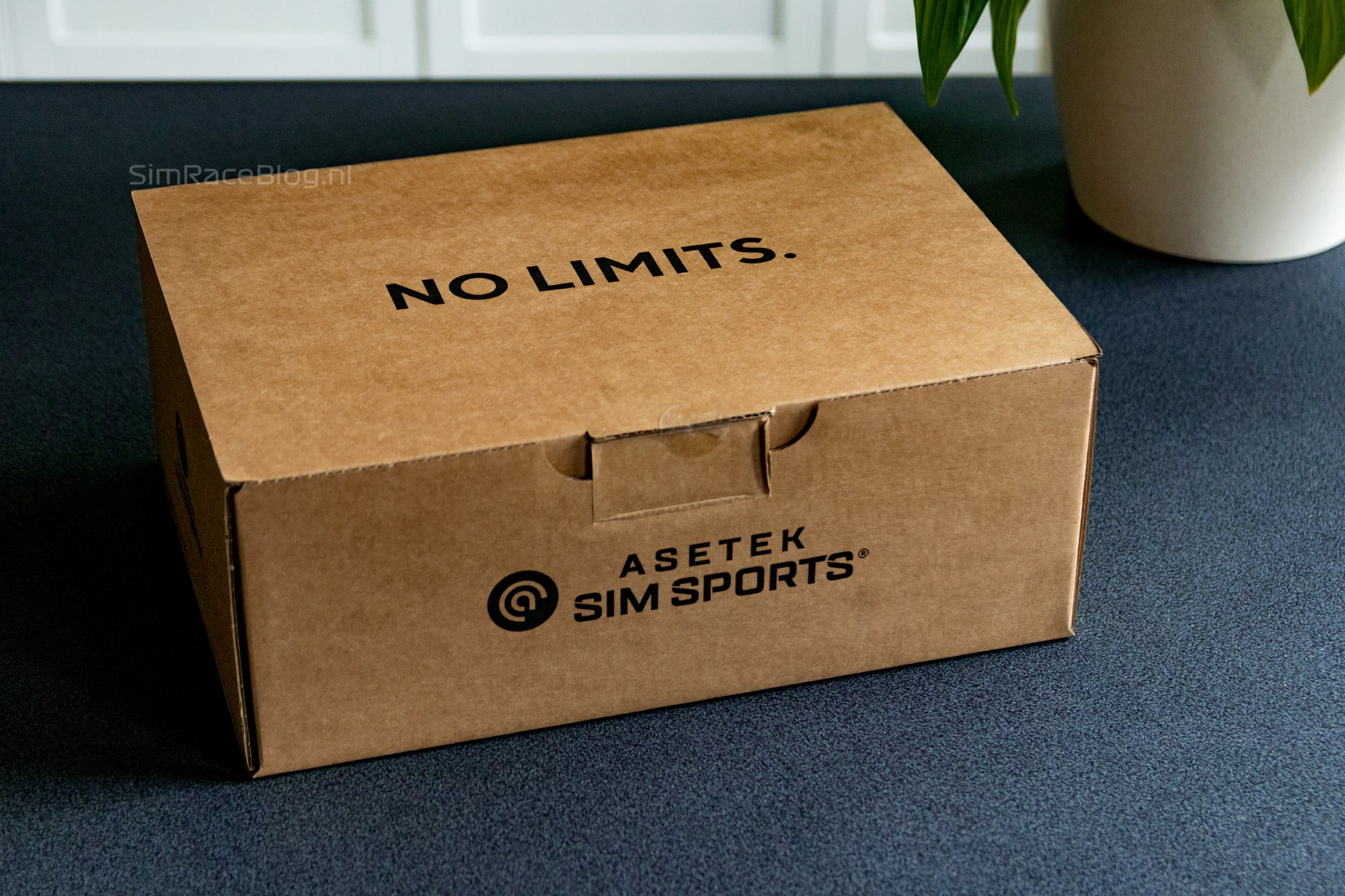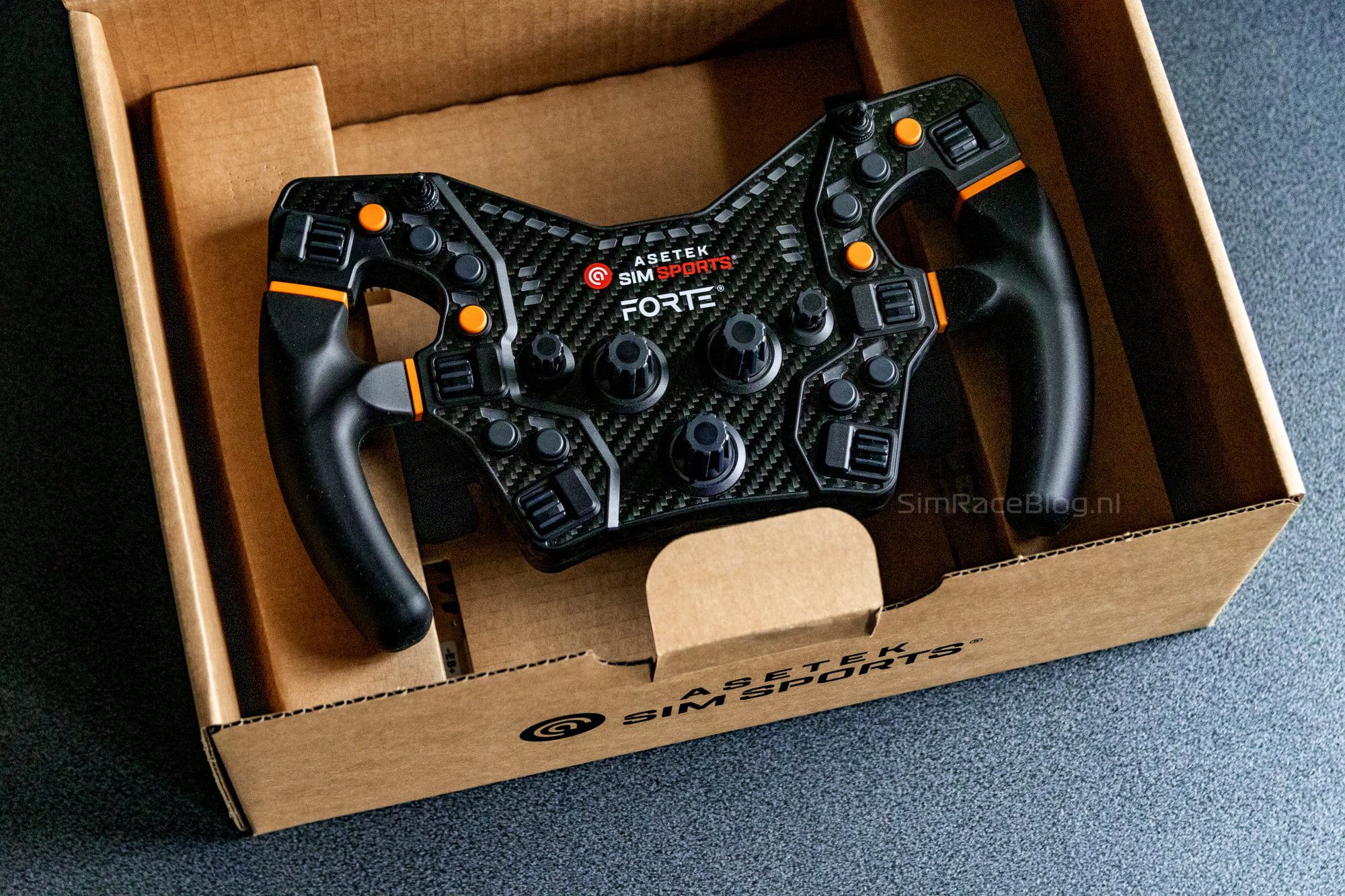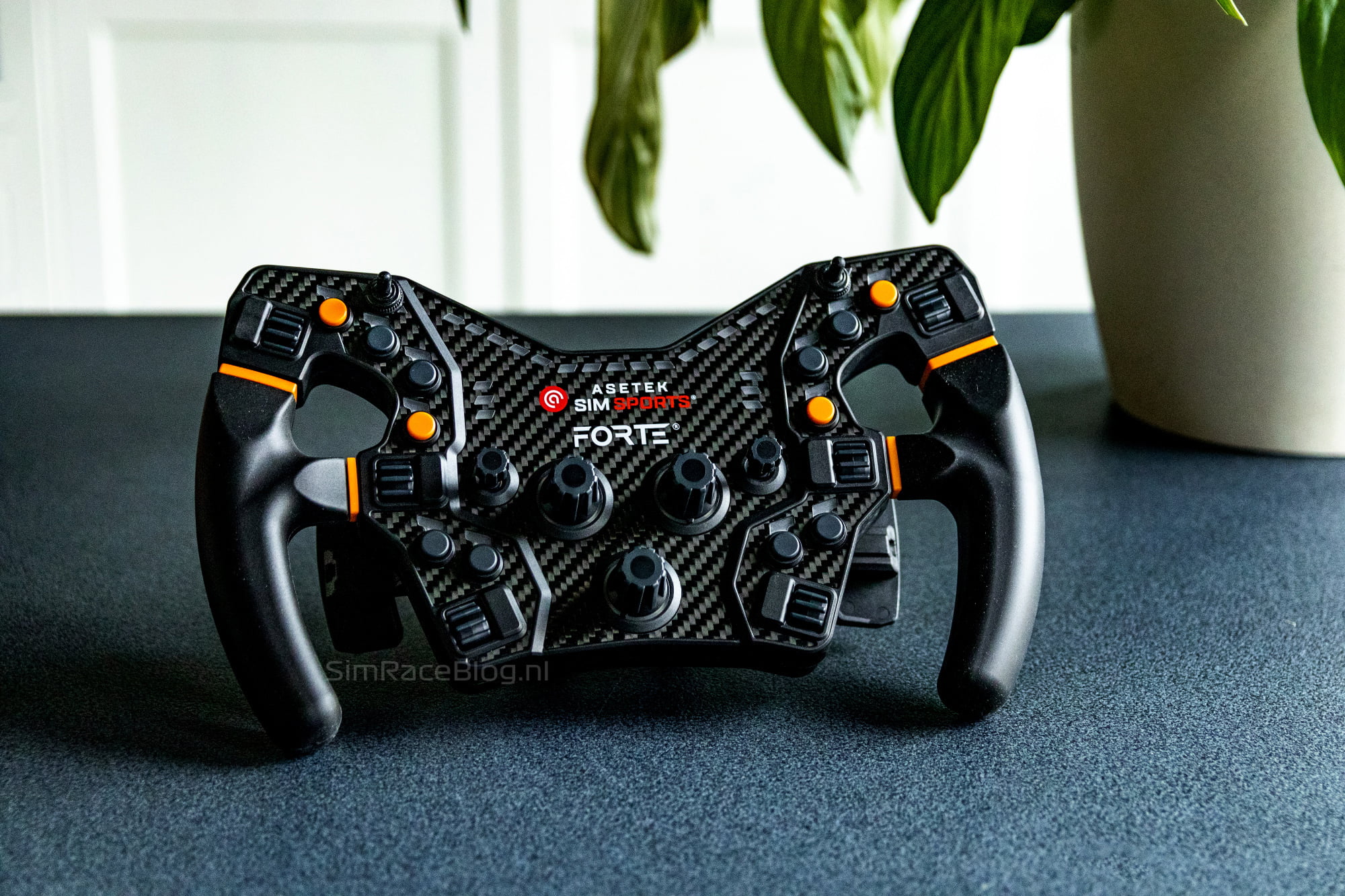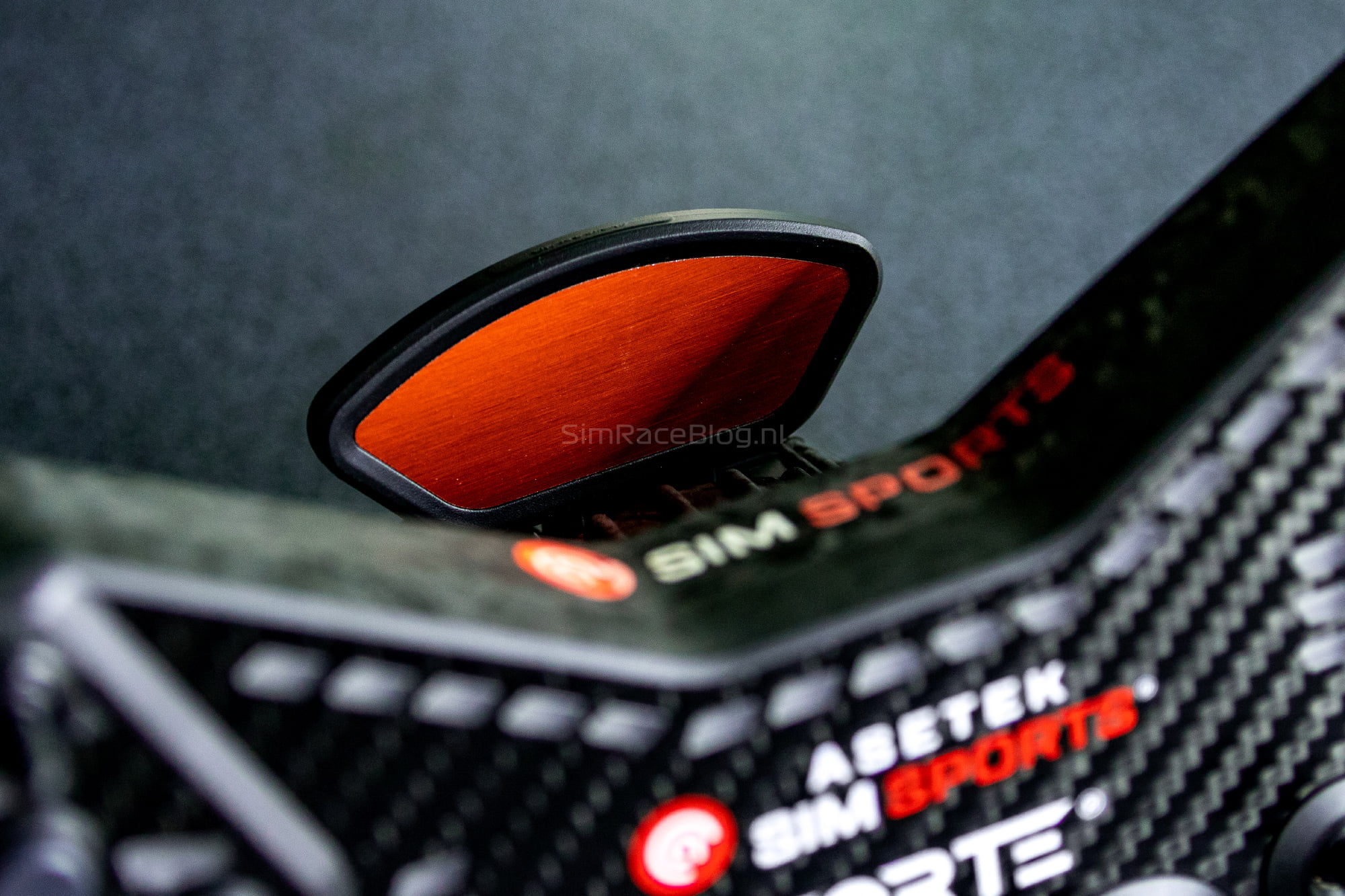Asetek Forte Formula Steering Wheel
Asetek SimSports, located in Denmark, is a brand that has established itself well in the sim racing landscape. For example, we have previously been able to test and review the Invicta and Forte pedal sets from Asetek. With their pedal sets they immediately showcased what they have to offer, what their philosophy is and how they immediately wanted to place themselves in the higher segment of sim racing hardware, which they clearly succeeded in doing. Soon Asetek SimSports broke the news that their line-up would not be limited to pedal sets. They gave the world a look behind the scenes through their channels and so a wheelbase, their own quick-release system and a matching steering wheel were announced. We were already enthusiastic about the pedal sets from Asetek, so we didn’t have to think twice about our answer to the question whether we wanted to test and review the Forte steering wheel.
The Asetek SimSports Forte steering wheel is a Formula-style steering wheel, equipped with their own developed Asetek Quick Release system, for use on an Asetek wheelbase. At the time of writing, the Forte steering wheel can be ordered as a pre-order from Asetek SimSports for €660.91.

Background
To better understand the essence of the Forte steering wheel, let’s first zoom out on the product range of Asetek SimSports. With the release of Asetek’s pedal sets, we were introduced to the names ‘Invicta’ and ‘Forte’, with the former used for the flagship model and ‘Forte’ for the more affordable option. Now that Asetek is expanding their product line-up it has become clear that these names were not only destined for the pedal sets, but to serve an entire product line. Additionally, Asetek has added another product line that functions as an entry-level series, which is placed beneath the Forte line and may bear the name ‘La Prima’. For example, Asetek now has wheelbases and pedals available in both the La Prima entry-level, the Forte mid-range and the Invicta top-class. The Asetek steering wheel is also included in these product lines, with the La Prima steering wheel and the Forte steering wheel being launched at the time of writing. The La Prima steering wheel is a stripped-down version of the Forte steering wheel.
Packaging & Contents
The shipment containing the Asetek SimSports Forte steering wheel and the Forte wheelbase, which we will discuss in a later review, was sent to us via UPS and delivered to us after three days. We receive one large brown shipping box which is otherwise completely blank. When opening the shipping box we find two white boxes with the Asetek SimSports logo on them and an additional package with the front mount for the wheelbase. When we saw the white boxes, we were under the impression that these would be very neutral product boxes with only the Asetek SimSports logo on them, but nothing could be further from the truth. The white boxes turn out to be extra outer boxes meant for shipping, because when open them we find the actual product boxes with full Asetek SimSports branding, images of the Forte steering wheel, specifications et cetera. We always get excited when we see beautiful product boxes, especially when they are also neatly protected by an outer box. So we immediately feel ready to unpack this one.
When opening the product box we immediately see the center part of the steering wheel that is held in place by a cardboard frame which falls over the handles of the steering wheel, with the contours of what is located under the cardboard. A fun, creative solution for packaging, in our view. This cardboard frame is easy to remove after which we can see the rest of the steering wheel and take it out of the box. Under the steering wheel is a small booklet of safety information, a card that reads “Product Manual” and a QR code that we expect leads to it, a decal sheet with Asetek SimSports and Forte decals, a decal sheet with labels for on the steering wheel and plastic tweezers to place them accurately.
Engineering & Quality
At its core, the Asetek Forte steering wheel, which is a 290mm wide Formula-style steering wheel, consists of an injection molded chassis of a composite material made of plastic, fiberglass and carbon fiber. Inside the chassis of the steering wheel is an extra metal plate which Asetek calls a “metal spider plate”. This plate is attached to the chassis and thus ensures more rigidity of the steering wheel. The silicone grips are screwed on to this metal plate inside the steering wheel, rather than directly to the chassis itself, to prevent the latter from being damaged. It’s Asetek’s philosophy that their products must be upgradeable, so they have announced that they will also release XL handles which you can swap yourself on the steering wheel. Furthermore, the front of the steering wheel is finished with 2mm thick carbon fiber front and a tasteful amount of orange accents, which we think certainly add character to the steering wheel.
Buttons & Inputs
The Forte steering wheel is equipped with a large number of buttons and input options. To start with, there are twelve regular push buttons, six thumb encoders, two momentary toggle switches, three non-pressable rotary encoders and two ‘kinky switches’ on the front. You can push the kinky switches in four directions, press them like a push button and turn them like a rotary encoder, so you have 7 input options with one switch. These kinky switches are actually fundamentally the same as what is known in the simrace community as ‘funky switches’ as they are called by competitor Fanatec. Finally, at the back side of the steering wheel, there are of course the magnetic shift paddles. The paddles themselves are plastic and the magnets are attached to the outer side of the paddle and module. In addition, there is material on the inside of the module that resembles a thin piece of felt, presumably to minimize the noise of the magnetic shift paddles and/or to soften the operating feel. The paddles can be adjusted in width by loosening one bolt. The back side of the steering wheel is also expandable with extra paddles for DRS and a Pit Limiter, for example, and a dual clutch setup. Unfortunately, we did not receive these from Asetek.
All buttons and inputs, except for the shift paddles, are equipped with ARGB LED lighting. Including the RPM LEDs and flag lights, the wheel has 49 programmable LEDs. These LEDs can be programmed to your own liking in Asetek’s software, called RaceHub. We will see later how this works in practice.
Quick Release
Because Asetek thought that Quick Releases could be done better, they chose to develop their own Quick Release system for their wheelbases and steering wheels. Where with most brands, if not all, you slide the steering wheel directly onto the output shaft of the wheelbase, Asetek has devised a system to slide the steering wheel into the quick release from above and secure it with a spring-loaded lever. This Quick Release contains contact points to provide the power supply to the steering wheel and the data exchange between the steering wheel and wheelbase. At first glance, this system looks very sturdy and, above all, user-friendly. However, the output shaft of the wheelbase is a lot thicker than is the case with Fanatec, for example. This means that, if you want to position your monitor between the steering wheel and the wheel base, you can’t position it as far down. The Quick Release is integrated in the Forte steering wheel, but the Quick Release adapter will also available separately. In addition, Asetek works with various steering wheel manufacturers to build software support and compatibility into the Quick Releases so that you can use third party steering wheels without having to connect the steering wheel to your PC with a USB cable. In that respect, it is very good to see that Asetek is working hard on their ecosystem, but at the same time does not lose sight of the wishes of the community by opening up this ecosystem to be used by other manufacturers as well.
Using the steering wheel
Since the Asetek Forte steering wheel is fundamentally a Formula-style steering wheel, we will of course also test it in Formula cars. We use both F1 22 and Assetto Corsa with, among other things, the RSS Formula Hybrid 2022 mod. We easily click the steering wheel with the Asetek Quick Release onto the Asetek Forte wheelbase, mounted on our FormulaSimRigs Avanzata simrig. The first impression of the Quick Release is that it is very easy to use. When we grab the steering wheel and pull the Quick Release lever back with two fingers, we can place it on the wheelbase in one smooth movement and in a fraction of a second. When releasing the Quick Release lever, the steering wheel is immediately fixed in place. We do not notice any play here, despite the fact that you would expect that there might be some margin with this system, which does not seem to be the case. The simplicity and speed of changing the steering wheel is unprecedented. In both F1 22 and Assetto Corsa we set up and configured everything in no time, so we can finally grab the wheel and start driving.

The steering wheel
With a width of 290mm, the Asetek Forte is a medium to large sized steering wheel. Due to the design in which the sides above the handles also rise, the steering wheel also feels like a reasonable-sized steering wheel while driving. The ergonomics of the silicone handles feel fine to us, they also offer us a good grip, but we do notice that they attract dust and dirt quite quickly, so regular cleaning may be desirable. The steering wheel chassis is, as described earlier, made of a composite material consisting of carbon fiber, fiberglass and plastic. In our experience, this ensures that the steering wheel, especially for its price range, feels quite plastic compared to other steering wheels. That being said, it’s a very solid steering wheel and we don’t feel any flex when driving, which is probably thanks to the metal plate inside the steering wheel. We feel the force feedback from the wheelbase coming through the steering wheel well and turning in with precision is no problem for us.
LEDs & Software
In Asetek’s RaceHub software we can manage all ARGB LEDs on the steering wheel. They have made this very easy by showing a picture of the steering wheel on the “Button Configuration” screen where we can simply select the buttons we want to change the color of the LED on. We can also select several buttons at the same time and click on a color once to make all selected LEDs change color. In this screen it is also possible to adjust the brightness of the LEDs. On the Shift Lights screen we can adjust the RPM LEDs. We can choose to light the LEDs from left to right, from right to left or from both left and right to center. We can indicate per LED at what percentage of RPM it will light up and with what color. There is an “Adjust Shift Curve” button on the screen, which helps you to fill in the individual steps of the LEDs when you adjust only the first and last LED. If we set the first LED to 80% and the last to 95%, with this button the software ensures that each subsequent LED lights up 1% later. We can also set a curve that adjusts the course of the LEDs at the touch of a button. Finally, on the last page we can easily modify the Flag Lights.
In practice, we find the LEDs on the steering wheel very pleasant. We always like it when there is more to customize and LEDs, in our opinion, generally add a lot to the appearance of a product. The colors look bright and saturated and the amount of colors you can choose from is more than enough. The brightness can be adjusted for the buttons, the shift lights and the flag lights, but in practice we don’t find the difference huge. The brightest setting is quite bright, and at the lightest setting there is more of a slight attenuation, but the LEDs cannot be dimmed really low.
What we run into with the LEDs is that their settings are not linked to the settings of the Asetek wheelbase. For the wheelbase we can endlessly create profiles for different sims and cars to adjust the force feedback, but the settings of the LEDs are not saved there. There is also no option to save or load profiles when configuring the LEDs themselves. This means that it makes no sense to figure out the ideal moments for several cars to make the RPM LEDs light up and match the RPM lights on the steering wheel of the in-game car. Even if you want to create multiple looks with the LEDs on the steering wheel for purely aesthetic reasons, you cannot save them. This is quite a loss if you want to have full control over the lighting and do not want to manually adjust all LEDs and RPM percentages for different cars or situations.
Front controls
At the front of the steering wheel are the large amount of buttons. The twelve push buttons are very nice to use; they require a good amount of force to be pressed and have a very short travel. The feedback we get when pressing the buttons is also very clear. The push buttons are reasonably easy to reach without completely releasing your grip on the steering wheel, but with the knowledge that Asetek will also be releasing XL handles for the steering wheel, we wonder whether the buttons could not have been just a little closer for the standard version because with smaller hands you do have to stretch.
The upper thumb encoders are in a reasonably convenient location and are a bit easier to reach. The feel of all six thumb encoders is good; the wheels don’t feel too light and you feel a clearly tangible, and slightly audible, click with every rotation. The top and middle thumb encoders are the most pleasant to operate because of their location, we are very accurate here in the amount of clicks we want to rotate them. We really have to stretch the lower thumb encoders, which can make it a bit more difficult to operate them with precision in the heat of battle. Of course you can solve this by assigning less essential functions to it.
We also find the momentary toggle switches, near the top edge of the steering wheel, quite far away but they are ingeniously placed at a comfortable angle that makes them easy to operate. This allows you to move your thumb in a natural direction to click the toggle switch. We find the three rotary encoders in the middle of the steering wheel easy to operate, they do require some persuasion when operating them, but they give good feedback when rotating. The fact that the rotary encoders cannot be pressed is a small loss. The two kinky switches are perfect and exactly what we expect from such a switch. We do think that at least one of them should have been within thumb’s reach so that you don’t have to release the grip on the steering wheel to navigate through a menu or a MFD.
Shifter paddles
We find the shifter paddles of the Asetek Forte steering wheel to be one of the weaker points of the steering wheel. Optically, the design looks good and has certainly been thought about, but the paddles are made of plastic and do not feel very pleasant or luxurious to the touch. While driving, we notice that the paddle shifters don’t really give the feedback we expected or hoped for. The resistance you feel to separate the magnets of the shift paddle and the module is nice, but at that moment you expect the travel of the shift paddle to end there. That is not the case; you can pull the gearshift paddle a little further towards you than the actuation point of the sensor. The resistance on this travel increases the further you pull the paddle towards you, which gives a bit of a squishy feel to shifting and doesn’t define a clear end point. The material between the shift module and paddle shifter also makes the return of the paddle a little softer, which is comfortable in principle, but which means that the feel of the paddle shifter in both directions is not really “snappy”. When we shift up or down, perhaps a little too quickly, we notice that the paddle shifters just don’t feel as responsive as we would have liked.
Driving Impression
We have uploaded a short driving impression of the Asetek Forte Steering Wheel, together with the Asetek Forte Wheelbase, to our YouTube channel and our Instagrampage. You can watch it below.
Conclusion
The Forte steering wheel, together with the stripped-down “La Prima” variant, is the first steering wheel that Asetek SimSports has brought to the market. Because Asetek entered the sim racing world with their strong Invicta and Forte pedal sets with a loud bang, our expectations of the Forte steering wheel were immediately very high. Too high, maybe.
The Forte steering wheel is fundamentally built with high quality materials, as we are used to from Asetek. The harmony of the chassis and the metal interior provides a very sturdy steering wheel on which we were not able to recognize any flex while driving. However, the choice of materials for the chassis means that the steering wheel feels quite plastic despite the degree of sturdiness, something that we can hardly get over in this price range. The steering wheel looks very good in terms of design and finish and we can see that a lot of time has been spent on it. The ergonomics of the handles feel good and have been able to provide us with sufficient comfort during our sessions.
The buttons and inputs on the front of the steering wheel are of good quality. The number of buttons and inputs is more than adequate and we’re pleased to see two self-proclaimed ‘kinky’ switches on the steering wheel. With the arrival of optional XL handles in mind, we think the buttons could have been a little closer to the thumbs. We find the shift paddles on the back of the steering wheel to be one of the weaker points of the steering wheel; these feel quite plastic and they don’t really feel ‘snappy’ to use despite the fact that they are magnetic.
The ARGB LEDs on the steering wheel are very nice and functional because you can set them as desired. The supplied labels are placed over these LEDs, so that labels of the buttons actually light up. A small flaw is that no profiles for the LEDs can be saved and that these settings are also not linked to the profiles of the wheelbase. This makes switching between cars with different RPM LED settings really impossible if you want the RPM LEDs to completely match what you see on your screen.
The Asetek Quick Release system has clearly been thought through; changing the steering wheel has never happened so quickly. The connection between wheelbase and steering wheel feels extremely solid and in our copy there is not a millimeter of play. We find the orange sprung lever on the steering wheel not great to look at, as it protrudes above the steering wheel.
All in all, the Asetek SimSports Forte steering wheel is a steering wheel that does nothing wrong fundamentally, but of which we secretly expected more. With a price tag of €660.91, the Forte steering wheel is anything but a cheap steering wheel. We see that other brands in the same price range, in our opinion, opt for materials that feel more luxurious and gearshift paddles that operate faster and give more feedback. That said, we suspect that a large part of this price is also in the development of, among other things, the Asetek Quick Release system which is of course integrated with this steering wheel, and the development of the software that controls the steering wheel and the Asetek wheelbases. This thought softens the price somewhat for us, knowing that this steering wheel is a good extension of the Asetek Forte wheelbase. In any case, we had a lot of fun driving it!
Interested in the Asetek Forte steering wheel? It can be ordered for a price of € 660.91 on the webshop of Asetek SimSports.
Do you want to stay informed about SimRaceBlog content, news, announcements and (future) give-aways? Follow us on Instagram @simraceblognl and/or our Discord channel.





































